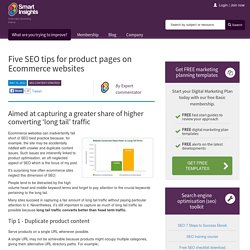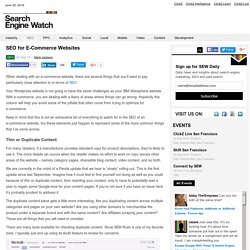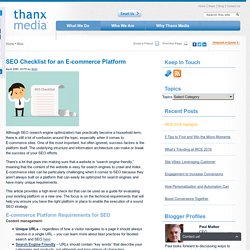

Five SEO tips for product pages on Ecommerce websites. Ecommerce websites can inadvertently fall short of SEO best practice because, for example, the site may be accidentally riddled with crawler and duplicate content issues.

Such issues are inherently linked to product optimisation, an oft-neglected aspect of SEO which is the focus of my post. It’s surprising how often ecommerce sites neglect this dimension of SEO. People tend to be distracted by the high volume head and middle keyword terms and forget to pay attention to the crucial keywords pertaining to the long tail.
Many sites succeed in capturing a fair amount of long tail traffic without paying particular attention to it. Nevertheless, it’s still important to capture as much of long tail traffic as possible because long tail traffic converts better than head term traffic. Tip 1 - Duplicate product content Serve products on a single URL whenever possible. A single URL may not be achievable because products might occupy multiple categories, giving them alternative URL directory paths. And. The Ultimate Guide To Technical SEO for Ecommerce 2016. Think of your website’s URLs as its addresses.

They should help your users find products and pages, then return to them at a later date. Many website admin systems (called Content Management Systems [CMS]) unfortunately generate unfriendly URLs on your website out of the box. Some automatically create them, whereas others allow you to choose the URL of each new page. Domain name There is an argument that having a domain name containing your ‘hero phrase’ will give you an advantage.
You should instead take the time to think about how your domain name comes across to users and potential customers in all markets you will target. If you’re selling into the UK, we recommend going for a .co.uk or other UK-orientated domain. Complicated URLs As mentioned previously, some CMS automatically generate poor URL formats such as the one below in red: These URLs make it hard for your users to return to the page or figure out what’s actually on it. You want friendly URLs, like the green example above. Search Engine Friendly eCommerce Platform - Enterprise Technology News. 19 SEO Features of eCommerce Platform. SEO for E-Commerce Websites. When dealing with an e-commerce website, there are several things that you’ll want to pay particularly close attention to in terms of SEO.

Your Wordpress website is not going to have the same challenges as your IBM Websphere website. With e-commerce, you are dealing with a litany of areas where things can go wrong. Hopefully this column will help you avoid some of the pitfalls that often come from trying to optimize for e-commerce. Keep in mind that this is not an exhaustive list of everything to watch for in the SEO of an e-commerce website, but these elements just happen to represent some of the more common things that I’ve come across. Thin or Duplicate Content For many retailers, if a manufacturer provides standard copy for product descriptions, they’re likely to use it. We are currently in the midst of a Panda update that we hear is “slowly” rolling out. The duplicate content piece gets a little more interesting. SEO Checklist for an E-commerce Platform. Although SEO (search engine optimization) has practically become a household term, there is still a lot of confusion around the topic, especially when it comes to E-commerce sites.

One of the most important, but often ignored, success factors is the platform itself. The underlying structure and information architecture can make or break the success of your SEO efforts. There’s a lot that goes into making sure that a website is “search engine friendly,” meaning that the content of the website is easy for search engines to crawl and index. E-commerce sites can be particularly challenging when it comes to SEO because they aren’t always built on a platform that can easily be optimized for search engines and have many unique requirements.
This article provides a high level check list that can be used as a guide for evaluating your existing platform or a new one. Content management: International Requirements: Basic Implementation Requirements: The Ultimate Guide to SEO for E-commerce Websites. There’s no question that ranking higher than your competitors on Google is a must.

But, what if you don’t know the SEO tips and tricks that will get your e-commerce site to the top? If you’re missing out on clicks, you’re probably also missing out on sales. Whether you’re just getting started with a new website or improving an existing site, this complete guide provides useful tactical suggestions for stepping up your SEO game. These days, reaching the first page isn’t enough. You must rank #1. In 2011, Search Engine Watch reported that a research study by Optify discovered that “websites ranked number one received an average click-through rate (CTR) of 36.4 percent; number two had a CTR of 12.5 percent; and number three had a CTR of 9.5 percent.” Another study by Gabe Donnini at Marketing Land last year supported Optify’s findings. What does this mean in layman’s terms?